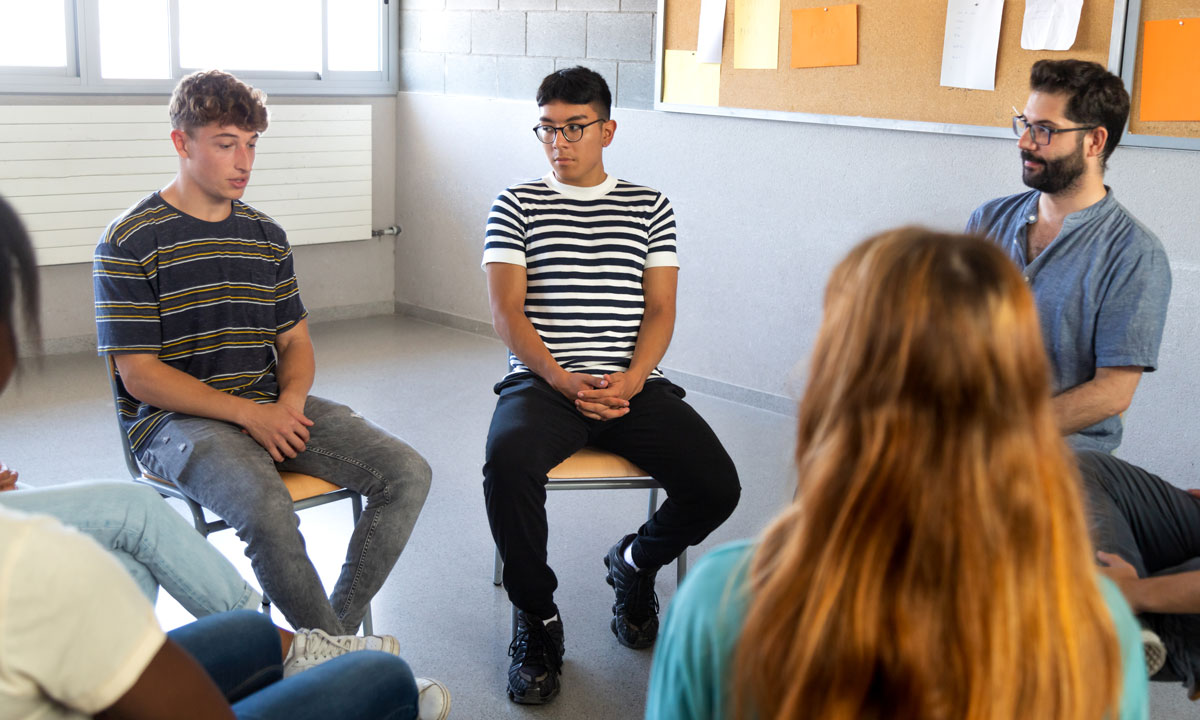Educator’s View: Restorative Justice Can’t Work If There Aren’t Enough Teachers
Coffey: I taught at a school where restorative justice genuinely worked, and we had something else essential: a robust staff

Get stories like these delivered straight to your inbox. Sign up for The 74 Newsletter
As schools face rising behavioral challenges, debates rage on about restorative justice, which rejects traditional, punitive discipline in favor of relationship-based work to address underlying causes of conflict. Studies show widely disparate results — for example, on school violence and academic performance.
Many advocates explain these discrepancies by noting that neutral-to-negative results come about when schools cherry-pick restorative practices — a restorative circle here, a peer mediation there — without fully committing to a schoolwide culture shift. When this happens, schools end up neither assigning consequences (as traditional discipline would do) nor truly addressing underlying issues (as restorative justice ought to do).
They’re right. Restorative justice has limited chances of success if the whole school community fails to embrace values like respect and authority. School culture isn’t the full story, though. I know, because I taught at a school where restorative justice genuinely worked, and we had something else essential: a robust staff. All the well-meaning culture shifts in the world can’t accomplish much if there aren’t enough adults in the building.
Restorative justice requires strong student-teacher relationships, and those relationships can’t flourish when teachers have too many students. Consider my teaching experiences.
- School 1 (a restorative justice school): Each term, I taught about 40 students in all my classes combined. I really got to know them. I saved their get-to-know-you surveys for regular reference; gave detailed, personalized feedback on assignments; and chatted with them between classes and during lunch.
- School 2 (not a restorative justice school): I taught as many as 175 students a semester. I graded unending piles of papers every “free” moment, giving minimal feedback beyond rubric markings. When I did have the rare opportunity to connect with students, there were enough minutes in the day for only a tiny fraction of the number I taught.
It’s simply not possible for teachers to develop meaningful relationships when classes are packed and teachers stretched thin. But what’s more, restorative practices are time-consuming.
Take, for instance, the restorative conference. At School 1, we called them STACs: student-teacher-advocate counselor conferences. When a student and I were struggling to communicate in the face of some challenge — incomplete work, disruptive classroom behavior, you name it — we could schedule a STAC to share each of our perspectives, discuss possible solutions and create an action plan. These conferences were genuinely helpful for students and teachers alike. But they also occupied many of my planning periods. If I had been scrambling to grade for lengthy rosters, or if I had STACs with dozens and dozens of students, it would have been impossible. Restorative justice takes time that a lot of teachers don’t have, and there isn’t a way around that besides improving student-teacher ratios.
Having a strong team of social workers or school psychologists also helps a ton. Our advocate counselors were trained social workers, and teachers relied on them to facilitate our conferences and to provide insight into individual students’ perspectives. This was possible because our counselors also had manageable rosters, so they were able to develop meaningful relationships with their students as well.
But while the School Social Work Association of America recommends a ratio of 250 students per social worker, no state comes close. The national average is 2,106 students per social worker — almost 10 times the recommended number. In fact, many social workers have to divide their time among multiple schools, which makes it harder for them to feel belonging within any community — creating yet another obstacle to establishing an effective restorative justice program.
The good news is that restorative justice has the potential to benefit all students, and especially those of color. When done right, it can decrease racial discipline gaps and improve academic achievement, attendance, credit completion rates and graduation rates — all measures by which students of color tend to face a disadvantage.
The bad news, though, is that children of color remain most likely to attend schools that are understaffed and/or experiencing high teacher turnover, factors that put more responsibilities on the educators who remain — overloading their workdays and pushing effective restorative justice further out of reach. Teachers of color can be especially successful with restorative justice, particularly for students of color, yet their retention rates are worse than those of white teachers — and might be getting even worse in the aftermath of remote learning.
School social workers, too, have seen their workload increase with the rise in pandemic-related student trauma. On top of that, access to mental health professionals continues to decrease for many Black and Hispanic students.
Advocates who care about restorative justice need to do more than talk about culture shifts. Pushing restorative justice forward without making a corresponding investment in human resources will prove fruitless at best, and harmful to students and teachers at worst. Improving teacher retention and growing school social worker teams are essential for enabling restorative justice to produce consistent benefits for all students— and especially those at the greatest disadvantage.
Get stories like these delivered straight to your inbox. Sign up for The 74 Newsletter

